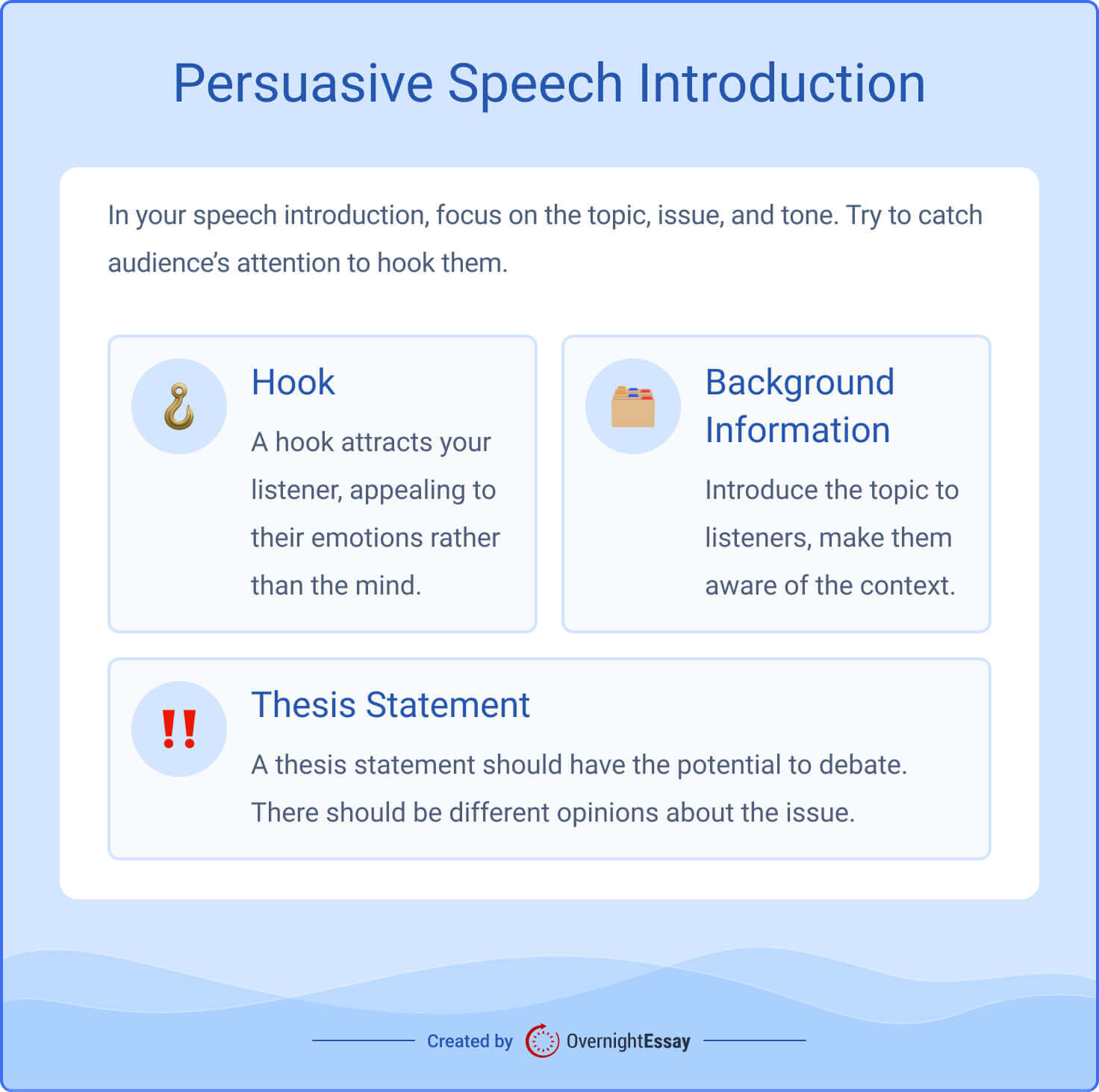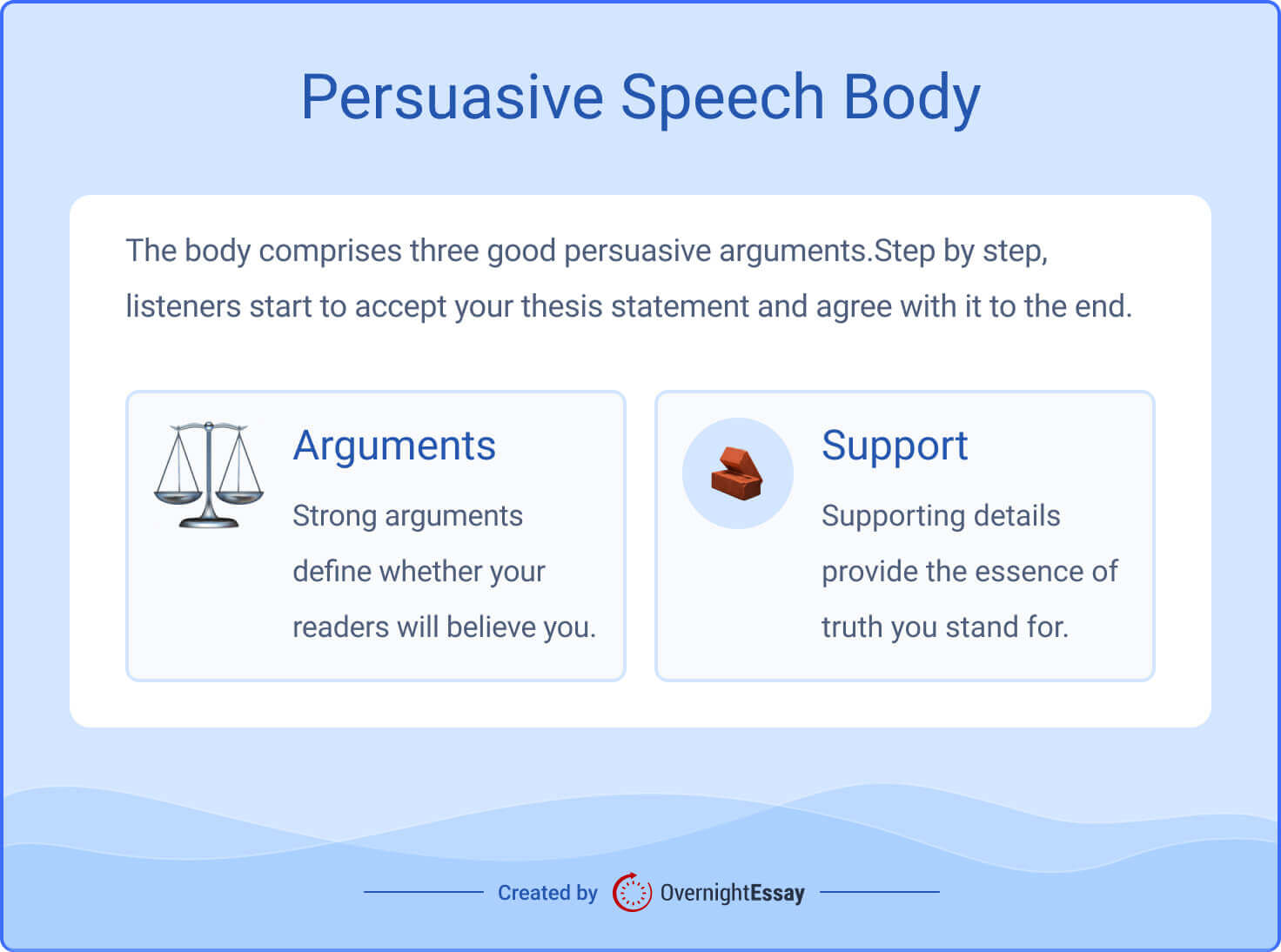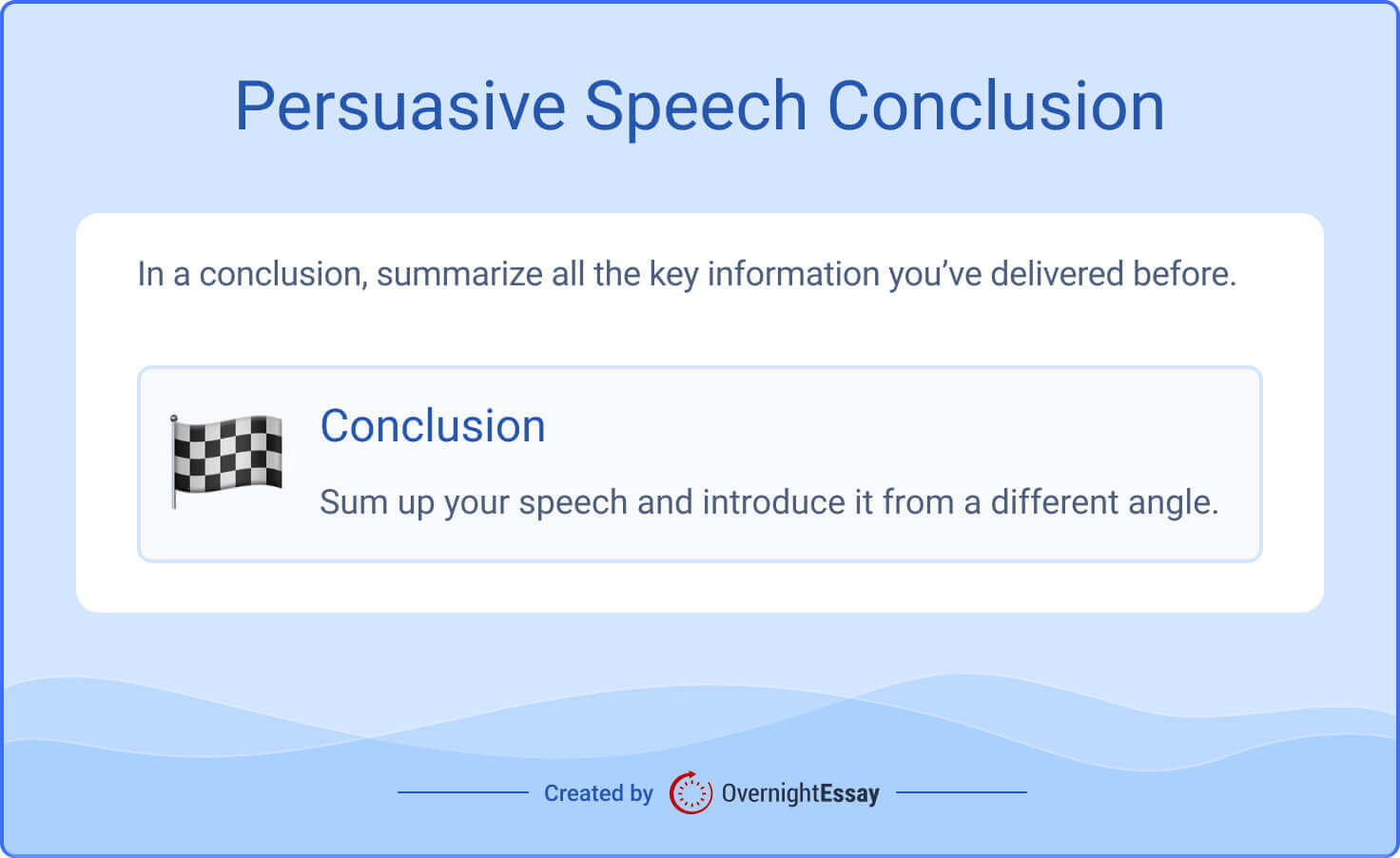
Are you ready to make a perfect persuasive speech?
Persuasion is a powerful tool to discuss controversial topics such as abortion, immigration, or gun control. You can receive this task as a college or high school student. However, practice in public speaking is never unnecessary. It is a helpful skill in any life situation you can think of.
Read this article to learn what a persuasive speech is and how to outline it. We will discuss the structure of a persuasive speech, its format, and your goals as a speaker.
Let’s start!
🗣️ What Is a Persuasive Speech?
Before you start working on a persuasive speech, you need to understand the task and goals clearly. Persuasion as an academic task has specific requirements.
Let’s start with the basics. At this stage, we will define the concept and discuss the main parts of a persuasive speech.
Persuasive Speech Definition
A persuasive speech is a type of speaking used to convince the listeners that the speaker’s point is valid. It influences the audience’s values, attitudes, and beliefs.
The structure of a persuasive speech implies listeners agreeing with you fully or partially. That is why your audience’s willingness to agree with your perspective measures the success of your speech.
For example, a sales pitch is a type of persuasive speech. In this case, the amount of people who bought a good or consider buying it defines the salesman’s success.
Purpose of Persuasive Speech
When you start working on a speech, determine the purposes. Get to know how to make a persuasive speech outline below.
Here are the main goals:
- Convince. Make the audience believe what you’re saying. Provide solid arguments and evidence.
- Actuate. You need to inspire people to take action in the direction you suggest.
- Stimulate. If the audience already believes in a particular viewpoint, your goal is to enhance it.
- Change. Some of the listeners might have different values and opinions. Even opposite to the ones you promote. You should change their perspective.
- Be ethical. You might use emotional language to convince your audience. Just make sure that your words, tone of voice, and body language don’t offend anyone.
Parts of a Persuasive Speech
Let’s define the main parts of your outline. Use this guide to create a persuasive speech outline.
📑 Persuasive Speech Outline
The structure of a persuasive speech consists of three main parts: introduction, body, and conclusion.
Each of them possesses specific characteristics and persuasion techniques. Persuasive speech organizational patterns might seem similar to an essay structure. The critical difference is that you also have to use your intonation and body language when making a speech.
Persuasive Speech Introduction
Of course, the best decision is to start with a hook. Your listeners will be thinking about it even after you finish the speech. That is why you need to invest time and effort to create a good hook.
After the hook, you need to introduce the main problem, provide background information, and add essential facts. Explain its importance and relevance.
- The final statement of your intro is a thesis – the basis of the whole speech. It should identify your position, be credible and easy to understand. Basically, you need to summarize your points in one sentence. Then you can provide a short preview of your speech. Introduce the main points that you will cover in the order they will appear.

Persuasive Speech Body
All of the paragraphs in the body of your speech should support the thesis you present. Depending on the type of task, those can be arguments, solutions to problems, causes, or effects. This is where you don’t have to share your position on the issues discussed.
- Then you can introduce the arguments that prove your thesis. Use facts, statistics, and other scientific data to support your statements. To make your audience trust you more, explain what the sources are and their credibility.
PRO TIP: Think about the possible counterarguments when you prepare a persuasive speech outline. You can also disprove the opposing point of view in one of the body paragraphs.

Persuasive Speech Conclusion
In the concluding paragraph, you have to repeat everything essential in your speech. Start with the thesis and the problem and then go through the arguments – present them from a different angle, connect with the thesis and summarize. Try to paraphrase everything and don’t use precisely the exact words.
- A conclusion is a part of a persuasive speech that shouldn’t include any new information. You can only synthesize and summarize what you have already said. Tell your listeners the results of your speech and what you want them to learn or do. Call to action if it is the purpose of your speech.

⚙️ Persuasive Speech Organizational Patterns
In this part of our article, you will learn how to write a persuasive speech outline. Here are some format examples that you can use in your preparation.
Persuasive Speech Outline Template #1
Monroe’s motivated sequence is a method of structuring your persuasion strategy. Use it to convince your audience by showing them they have a psychological need and giving them tools to satisfy it.
Here are the main components of Monroe’s motivated sequence:
- Attention. Interest your audience with an interesting fact, quotation, rhetorical question, joke, or dramatic story. Think about what can make them want to listen to you.
- Need. Convince them there is a problem that affects and needs a solution. Tell your audience about the consequences of not solving the issue.
- Satisfaction. Provide your solutions that listeners can implement to the problem. As in an argumentative essay, prepare to the possible objections that you will have to disprove.
- Visualization. Tell what can happen if the problem remains. Compare it with the opposite situation.
- Action. Clarify what your audience has to do to fight the problem and satisfy their need.
Persuasive Speech Outline Template #2
Problem-Cause-Solution is another method that you can use to outline your speech. You should explain the problem and its causes and suggest your solutions so that your audience can agree.
Here are the parts of a problem-cause-solution format:
- Problem statement. Introduce the problem that you will discuss. Clarify how it affects the listeners and its importance in general.
- Causes. Connect the issue with the factors that cause it. Specify how the audience might contribute to the origins of the problem.
- Solutions. Address the causes and introduce your solutions to each of them. Specify what your audience should do.
Persuasive Speech Outline Template #3
Comparative advantages format is another persuasive speech organization pattern. In this case, you need to convince your audience that your suggestions are the best by comparing them with the others.
Outline your speech using these steps:
- Introduce the problem. Summarize the essential information about the issue you will discuss.
- Compare the solutions. Introduce several solutions and explain which one is the best. Convince your listeners that the chosen solution is the right choice.
- Final appeal. Motivate the audience to accept the best solution and to take action in the direction you proposed.
🫀 Persuasive Speech Outline Example #1. Monroe’s Motivated Sequence
And here, we will show examples of how to create a persuasive speech outline using different techniques. Let’s start with Monroe’s motivated sequence.
Organ Donation Persuasive Speech Outline
Introduction
- Attention. Provide shocking statistics about how many people die because they need grafts they cannot receive. You can also choose a touching story provoking your audience’s emotions.
Body
- Need. Explain why society needs more volunteers who donate organs. Support your opinion with gathered research data.
- Satisfaction. Describe the process of volunteering and the requirements people need to meet to become a donor. Provide various ways, such as marking it on a driver’s license or having a conversation with one’s family.
- Visualization. Explain how many lives a person can save. Make it clear how many people die because of a lack of donors. Then demonstrate how many could be saved if there were more volunteering donors.
Conclusion
- Action. Paraphrase the suggested solutions into a call to action. Describe a step-by-step plan of becoming a donor. You can end your speech with a motivational quote.
🚘 Persuasive Speech Outline Example #2. Problem-Cause-Solution
Here is another example of a persuasive speech outline. Take a look at the problem-cause-solution outline format below.
Texting and Driving Persuasive Speech Outline
Introduction
- Problem statement. Ask your audience if they have ever texted while driving. Provide some information on the resulting death rates and other consequences.
Body
- Causes. Explain the main reasons for the accidents. They include lack of attention and putting your hands off the wheel when it comes to texting. You might also discuss psychological factors, such as thinking that you have everything under control or that you are an experienced driver.
- Solutions. Educating drivers on the dangers of raising fines might work as a governmental policy. Highlight that every listener can still influence the situation. Every smartphone has a “no disturb” mode. You can suggest silencing calls and social media notifications while driving.
Conclusion
Summarize the problems and the solutions you discussed. Remind why drivers need to be attentive on the road and what dangers texting possesses. Prepare a course of action for your audience.
♻️ Persuasive Speech Outline Example #3. Comparative Advantage
It is our last outline in this article. Check the comparative advantage outline on recycling here.
Recycling Persuasive Speech Outline
Introduction
- Introduce the problem. Discuss the current situation concerning the amount of garbage and the trends. Provide some statistics of how much waste a usual household produces. Make sure that everyone understands the global impact.
Body
- Compare the solutions. State their advantages and disadvantages and choose the best one. Here are some possible solutions:
- Collect and sort recyclable waste. Having separate containers for different kinds of waste is a must for modern people.
- Buy goods made of recycled materials. It just takes a few seconds to choose such goods in local supermarkets and then implementing this habit.
- Buy second-hand products. It can be clothes, furniture, or anything you can think of.
- Buy goods of better quality. It still means that you will have to recycle them. But more durable products are still better for ecosystems as you buy less.
Conclusion
- Final appeal. Suggest ways to implement the solution you have chosen. For example, tell where they can buy certain goods and the packaging symbols they need to pay attention to.
🎙️ Persuasive Speech Topics
Now that we’ve comprehensively instructed you on persuasive speech outlining, it’s your turn!
We would love to know your persuasive speech experience – share them in the comments below.
Good luck!
These tips are great in wniitrg an essay. I agree with you that in wniitrg one with topic of your choice, it’s easier if you will choose a topic that interest you. You will have more ideas and information you can add on your essay. Thanks for this!